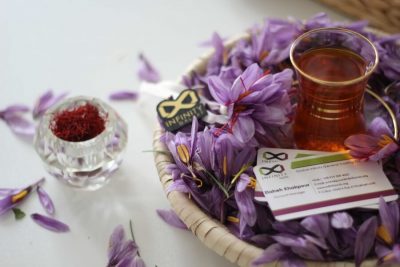Saffron: The Red Gold

Types of Saffron
- Negin/Super Negin: This type is similar to ordinary red threads of saffron, but it is thicker and longer. Negin and Super Negin saffron have the highest levels of coloring potency. Super Negin is very popular due to the beautiful and identical appearance of threads with no white part of the style.
- Sargol: This type contains pure stigmas without the styles. This type of saffron is produced from batch saffron by cutting the white parts with scissors and then using the static electricity method. Sargol and Negin are as same as each other in terms of color and quality. However, Sargol threads are not as long and thick as Negin. Therefore, Sargol is cheaper than Negin or Super Negin. It is identical to the Spanish Coupé Saffron.
- Pushal: It contains the red part of the style with a tiny amount of white part of it.
- Saffron cluster: This type of saffron contains all the saffron style, the red part of saffron (stigma) along with the white part. The colouring power (amount of crocin) is usually lower than other types but the smell is stronger.
Components
The bitter and strong aroma of this red precious spice is due to the presence of a colourless essential oil with terpene and an oxygenated combination with cineole, called safranal. To be more specific, they relate the taste to the bitter heteroside of picrocrocin, which is soluble in water and alcohol. Besides, it is rich in carotenoids.
- The two main natural carotenoids in saffron are crocin and crocetin, which cause the pretty red colour of it. It’s also needful to mention that the aromatic characteristics of saffron is for the existence of volatile compounds. In the good quality, we can find 2.5% of each compound including:
- The yellow compounds that are well soluble in water (crocetin derivatives).
- The bitter compounds include picrocrocin which is especially stomach tonic.
- The aromatic substances (essential oils) that the most important one is safranal which sometimes makes up to 1%.
Additionally, the moisture content is about 10-12% and the mineral compounds are about 5%.
Benefits
The beneficial content of saffron and its active ingredients affect various organs of the body including:
- Central nervous system, gastrointestinal tract, liver, kidney, cardiovascular system, hematopoietic system
- Immune system, endocrine system (coordination and integration of different tissues under the control of the nervous system and other chemicals called hormones.
Scientists have found numerous therapeutic properties of saffron, including:
- Anti-depressant, anti-anxiety and hypnotic effects, anticonvulsant
- Muscle relaxant, analgesic and anti-inflammatory
- Antioxidant, anti-Alzheimer, anti-tumour, hypoglycemic and antitussive.
-
The presence of carotenoids has caused anti-atherosclerotic and anti-tumour effects.
How to Store Saffron?
especially before and after grinding, should be kept away from light and moisture, in a closed container. Since its aromatic substances can evaporate, if you store it improperly, it will lose its aroma over time. In the case of air and light exposure, its medicinal effects and taste decrease as the quality fades.
Saffron Consumption
The most common way to consume spice is to brew saffron over warm steam in countries such as Iran. Local people usually ground the threads with mortar and pestle to release the taste and colour faster and efficiently. After grinding, they pour some boiling water on it and let it rest for 10 – 15 minutes. The rest helps extract saffron’s taste and colour better. The amount of water should be less than a third of the glass and its saffron be about a tablespoon or more.
The second method that we can refer to is the use of ice. For this method, it is better to put it in a container after grinding and place small ice cubes in it. Let the ice cubes melt at room temperature and the extract comes out.
Genuine saffron releases the colour gradually in the time of the rest. If the saffron release sudden colour in cold water, it is fake or adulterated.
Generally speaking, the primary uses of saffron include food, medicine and chemical (industrial). Saffron gives a special aroma and colour to food; therefore, industries such as sausage making and confectionery use it to give their products a nice smell and taste. In pharmaceutical industries, experts use it in antidepressants. The textile industry also uses saffron in the case of dyeing silk fabrics. Dairy production and alcoholic beverages, and non-alcoholic industries use saffron as a natural flavouring as well.
Cultivation and Farming
Product farming is relatively simple but it needs some specific climate conditions. Its harvest cycle takes 3 – 4 months, and it might reach a height of 15-20 cm. The soil must be fertile and moist soil. The plant is grown in dry places. Harvest of Product is difficult due to its sensitive style. But the procedure is significantly lucrative if the farmer pays attention to the quality. Here are several benefits of saffron cultivation:
- Low water requirement
- High economic value
- Export and currency exchange
- Possibility of operation for up to 9 years
- Long product life cycle
- No need for heavy machinery and special technology
- Convenient transportation

